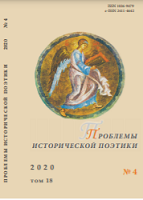Семантика времен года в романе Л. Толстого «Воскресение»
Semantics of Seasons in the Novel Resurrection by Leo Tolstoy
Author(s): Elena MasolovaSubject(s): Christian Theology and Religion, Studies of Literature, Semantics, Russian Literature, 19th Century
Published by: Петрозаводский государственный университет
Keywords: Leo Tolstoy; seasons; enlightenment; resurrection; existential time; ontological semantics; Old Russian literature; Christian Realism;
Summary/Abstract: The article is devoted to the revealing of the seasons semantics in Tolstoy’s novel Resurrection. Having examined the events happening to the characters of Tolstoy’s novel during 15 years of their life we came to the conclusion that in Resurrection the depicted seasons are associated with reconstruction of humanity’s steady movement towards God. The description of spring at the beginning of the novel is a parable-like prologue that affirms the idea of mankind’s future spiritual resurrection. In spring, 29 year-old Nekhlyudov decided to redeem himself in front of Maslova. When the main character recollected the spring of his youth, he realized social ill-being and the need to find the lost harmony with the world thus, he abdicated from his right to the land ownership. Student Nekhlyudov saw in summer nature a source of inspiration; in summer, escorting prisoners to hard labor, the character understood the roots of social evil, and prisoner Maslova returned to her original pure self. The spiritual spring of Nekhlyudov takes place in a calendar spring, and his spiritual resurrection happened in autumn; Maslova’s spiritual spring coincides with a calendar summer. The character comes to the adoption of Christianity in fall reading the Gospel. In the finale of the novel, early winter “rushes” the earth’s renewal; Nekhlyudov’s enlightenment is predetermined by changes in nature and by the indisputable rightness of God’s Word which had been revealed to him. In Resurrection, the seasons become the markers of being and gain the ontological significance. Spring symbolizes future moral enlightenment of the mankind; summer is a symbol of life; fall “strengthens” Nekhlyudov’s religious searches, “convincing” him to build life according to God’s covenants; winter is a cleansing preparatory period that precedes the spiritual resurrection of people. The epic character by Tosltoy emerges due to the correlation of natural calendar with the semantics of seasons developed in Old Russian literature. The novel Resurrection is an artistic work of Christian realism that continues the tradition of Old Russian literature.
Journal: Проблемы исторической поэтики
- Issue Year: 18/2020
- Issue No: 4
- Page Range: 229-247
- Page Count: 19
- Language: Russian

